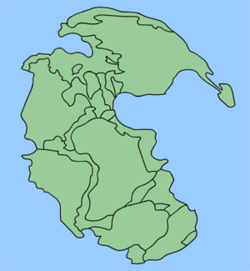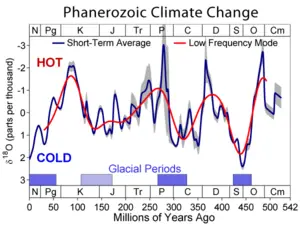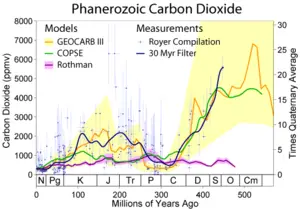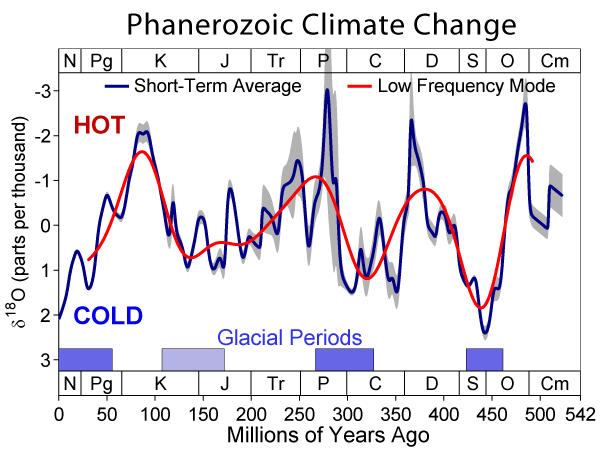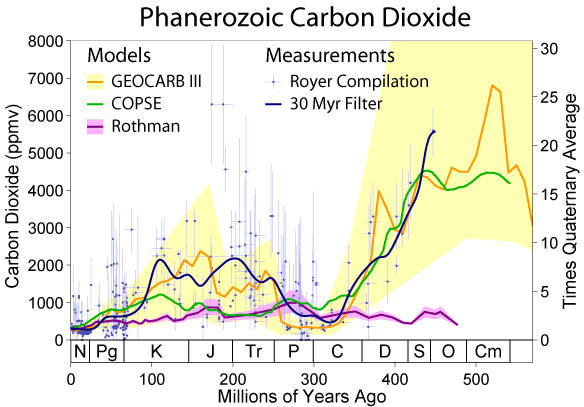Difference between revisions of "Phanerozoic" - New World Encyclopedia
Rick Swarts (talk | contribs) |
Rick Swarts (talk | contribs) |
||
| Line 1: | Line 1: | ||
[[Image:Phanerozoic Biodiversity.png|300px|right|thumb|During the Phanerozoic the [[biodiversity]] shows a steady but not monotonic increase from near zero to several thousands of genera. ]] | [[Image:Phanerozoic Biodiversity.png|300px|right|thumb|During the Phanerozoic the [[biodiversity]] shows a steady but not monotonic increase from near zero to several thousands of genera. ]] | ||
| − | The '''Phanerozoic''' (occasionally '''Phanaerozoic''') | + | The '''Phanerozoic''' (occasionally '''Phanaerozoic''') eon is the period of [[Geologic timescale|geologic time]] spanning from the appearance of macroscopic hard-shelled [[fossil]s, roughly 542 million years ago (mya), to the present time. Preceding the Phanerozoic is the [[Precambrian]], an informal name for [[Geologic time scale#Terminology|eons]] of the [[geologic timescale]] that spans from the formation of [[Earth]] around 4.5 billion years ago, to the [[Cambrian]], which marked the appearnce of the diverse and abundant hard-shelled fossils. The Cambrian is the first period of the Phanerozoic era. The Phanerozoic eon is ongoing. |
| + | The Cambrian, which follows the Proterozoic era, is the age of the first major flowering of multicellular eukaryotes, when a majority of the skeleton-bearing phyla of animals appear in the fossil record (Mayr 2001). | ||
| − | |||
| + | Among the phyla that were first evident in the Cambrian were the [[brachiopod]]s, [[mollusk]]s, [[arthropod]]s ([[trilobite]]s), and [[echinoderm]]s. The entire preceding history of the Earth is referred to as the Precambrian, while the fossil-rich time from the Cambrian to the present is referred to as the Phaenerozoic eon, which is divided into the [[Paleozoic]], [[Mesozoic]], and [[Cenozoic]] eras (Mayr 2001). Mayr (2001) concludes that the apparent explosion of new phyla in the early Cambrian was possibly due to the skeletonization of a variety of soft-bodies organisms that already existed in the Precambrian. | ||
| − | The | + | The Phanerozoic is divided into three [[era (geology)|era]]s — [[Paleozoic]], [[Mesozoic]], and [[Cenozoic]]. In the older literature, the term Phanerozoic is generally used as a label for the time period of interest to paleontologists. The term seems to be falling into disuse in more modern literature. |
| + | |||
| + | The start of the Paleozoic, between roughly 542 mya and 530 mya, is a time that presents a major enigma for [[Darwinism|Darwinian evolution]]. This is is the phenomenon known as the [[Cambrian#Cambrian explosion|Cambrian explosion]], when there was a sudden geological appearance of a large number of body plans. Indeed, all of the major body plans (phyla) of complex, [[cell (biology)|multi-cellular]] macroscopic organisms that exist today appeared in this time period, and since then no fundamentally new body plan has come into existence. | ||
| − | |||
| − | + | the name Phanerozoic name derives from the Greek meaning ''visible life'', referring to the large size of organisms since the [[Cambrian explosion]]. | |
The time span of the Phanerozoic includes the rapid emergence of a number of animal [[Phylum (biology)|phyla]]; the [[evolution]] of these phyla into diverse forms; the emergence of terrestrial [[plant]]s; the development of complex plants; the evolution of [[fish]]; the emergence of terrestrial animals; and the development of modern faunas. During the period covered, [[continent]]s drifted about, eventually collected into a single landmass known as [[Pangea]] and then split up into the current continental landmasses. | The time span of the Phanerozoic includes the rapid emergence of a number of animal [[Phylum (biology)|phyla]]; the [[evolution]] of these phyla into diverse forms; the emergence of terrestrial [[plant]]s; the development of complex plants; the evolution of [[fish]]; the emergence of terrestrial animals; and the development of modern faunas. During the period covered, [[continent]]s drifted about, eventually collected into a single landmass known as [[Pangea]] and then split up into the current continental landmasses. | ||
| + | |||
| + | The exact time of the boundary between the Phanerozoic and the Precambrian is slightly uncertain. In the [[19th Century]], the boundary was set at the first abundant [[metazoa]]n [[fossil]]s. But several hundred [[Taxon|taxa]] of Precambrian metazoa have been identified since systematic study of those forms started in the 1950s. Most [[geologist]]s and [[paleontologist]]s would probably set the Precambrian-Phanerozoic boundary either at the classic point where the first [[trilobite]]s and [[archaeocyatha]] appear; at the first appearance of a complex feeding burrow called ''[[Trichophycus pedum]]''; or at the first appearance of a group of small, generally disarticulated, armored forms termed 'the [[small shelly fauna]]'. The three different dividing points are within a few million years of each other. | ||
| + | |||
{{Eon Footer}} | {{Eon Footer}} | ||
| Line 22: | Line 27: | ||
The Paleozoic era spanned from roughly 542 million years ago (mya) to roughly 251 mya (ICS 2004). It is subdivided into six [[geology|geologic]] periods. From oldest to youngest, these six periods are the [[Cambrian]], [[Ordovician]]*, [[Silurian]], [[Devonian]], [[Carboniferous]], and [[Permian]]*. | The Paleozoic era spanned from roughly 542 million years ago (mya) to roughly 251 mya (ICS 2004). It is subdivided into six [[geology|geologic]] periods. From oldest to youngest, these six periods are the [[Cambrian]], [[Ordovician]]*, [[Silurian]], [[Devonian]], [[Carboniferous]], and [[Permian]]*. | ||
| − | |||
| − | |||
[[Image:Pangaea.png|right|250px|thumb|Map of Pangaea, which began to form near the end of the Paleozoic]] | [[Image:Pangaea.png|right|250px|thumb|Map of Pangaea, which began to form near the end of the Paleozoic]] | ||
Revision as of 22:27, 4 January 2007
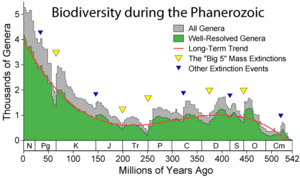
The Phanerozoic (occasionally Phanaerozoic) eon is the period of geologic time spanning from the appearance of macroscopic hard-shelled [[fossil]s, roughly 542 million years ago (mya), to the present time. Preceding the Phanerozoic is the Precambrian, an informal name for eons of the geologic timescale that spans from the formation of Earth around 4.5 billion years ago, to the Cambrian, which marked the appearnce of the diverse and abundant hard-shelled fossils. The Cambrian is the first period of the Phanerozoic era. The Phanerozoic eon is ongoing.
The Cambrian, which follows the Proterozoic era, is the age of the first major flowering of multicellular eukaryotes, when a majority of the skeleton-bearing phyla of animals appear in the fossil record (Mayr 2001).
Among the phyla that were first evident in the Cambrian were the brachiopods, mollusks, arthropods (trilobites), and echinoderms. The entire preceding history of the Earth is referred to as the Precambrian, while the fossil-rich time from the Cambrian to the present is referred to as the Phaenerozoic eon, which is divided into the Paleozoic, Mesozoic, and Cenozoic eras (Mayr 2001). Mayr (2001) concludes that the apparent explosion of new phyla in the early Cambrian was possibly due to the skeletonization of a variety of soft-bodies organisms that already existed in the Precambrian.
The Phanerozoic is divided into three eras — Paleozoic, Mesozoic, and Cenozoic. In the older literature, the term Phanerozoic is generally used as a label for the time period of interest to paleontologists. The term seems to be falling into disuse in more modern literature.
The start of the Paleozoic, between roughly 542 mya and 530 mya, is a time that presents a major enigma for Darwinian evolution. This is is the phenomenon known as the Cambrian explosion, when there was a sudden geological appearance of a large number of body plans. Indeed, all of the major body plans (phyla) of complex, multi-cellular macroscopic organisms that exist today appeared in this time period, and since then no fundamentally new body plan has come into existence.
the name Phanerozoic name derives from the Greek meaning visible life, referring to the large size of organisms since the Cambrian explosion.
The time span of the Phanerozoic includes the rapid emergence of a number of animal phyla; the evolution of these phyla into diverse forms; the emergence of terrestrial plants; the development of complex plants; the evolution of fish; the emergence of terrestrial animals; and the development of modern faunas. During the period covered, continents drifted about, eventually collected into a single landmass known as Pangea and then split up into the current continental landmasses.
The exact time of the boundary between the Phanerozoic and the Precambrian is slightly uncertain. In the 19th Century, the boundary was set at the first abundant metazoan fossils. But several hundred taxa of Precambrian metazoa have been identified since systematic study of those forms started in the 1950s. Most geologists and paleontologists would probably set the Precambrian-Phanerozoic boundary either at the classic point where the first trilobites and archaeocyatha appear; at the first appearance of a complex feeding burrow called Trichophycus pedum; or at the first appearance of a group of small, generally disarticulated, armored forms termed 'the small shelly fauna'. The three different dividing points are within a few million years of each other.
| Geologic Time (ca. 4500 million years ago - present) | |||
|---|---|---|---|
| Hadean | Archean | Proterozoic | Phanerozoic |
| Precambrian (ca. 4500 - 542 million years ago) | |||
| Phanerozoic eon (542 mya - present) | ||
|---|---|---|
| Paleozoic era | Mesozoic era | Cenozoic era |
The Paleozoic era (from the Greek palaio, meaning "old" and zoion, "animals", meaning "ancient life") is a major division of the geologic timescale and the earliest of three geologic eras of the Phanerozoic eon. It is followed by the Mesozoic and Cenozoic eras.
The Paleozoic era spanned from roughly 542 million years ago (mya) to roughly 251 mya (ICS 2004). It is subdivided into six geologic periods. From oldest to youngest, these six periods are the Cambrian, Ordovician, Silurian, Devonian, Carboniferous, and Permian.
Geologically, the Paleozoic era is theorized by some scientists to have begun shortly after the breakup of a hypothesized supercontinent and at the end of a global ice age. Throughout the early Palaeozoic era, the Earth's landmass was broken up into a substantial number of relatively small continents.
| Paleozoic era (542 - 251 mya) | |||||
|---|---|---|---|---|---|
| Cambrian | Ordovician | Silurian | Devonian | Carboniferous | Permian |
The Mesozoic era is one of three geologic eras of the Phanerozoic eon, being preceded by the Paleozoic era and followed by the Cenozoic. The Mesozoic extended from about 251 million years ago (mya) to 65 mya. The Phanerozoic eon, which is the fossil-rich time period that comes after the Precambrian, extends to the present day.
Mesozoic means "middle animals," derived from Greek prefix meso-/μεσο- for 'between' and zoon/ζωον meaning animal or 'living being'. The original name used by Giovanni Arduino, who divided time into eras in the 18th century, was "Secondary" (with the Paleozoic era labelled "Primitive" and the modern era the "Tertiary"). The prior Paleozoic was the era when most of the basic animal body plans came into existence.
The Mesozoic is separated into three geologic periods: Triassic, Jurassic, and Cretaceous. It is often called the "Age of the Dinosaurs," after the dominant fauna of the era. Many diverse animal species appeared during this time.
Just as in the development of a human, in the history of life on earth, later stages develop on the foundation of earlier stages. By the end of the Mesozoic era, the basis of modern life was in place.
| Mesozoic era (251 - 65 mya) | ||
|---|---|---|
| Triassic | Jurassic | Cretaceous |
The Cenozoic (sen-oh-ZOH-ik; sometimes the British English Caenozoic) meaning "new life" (Greek kainos = new + zoe = life) is the most recent of the three classic geological eras of the geologic time scale. It covers the 65.5 million years since the Cretaceous-Tertiary extinction event at the end of the Cretaceous that marked the demise of the last dinosaurs and the end of the Mesozoic era. The Cenozoic era is ongoing.
The fauna and geology that we see today is vastly different than what was the case in the Mesozoic era, but comes on the foundation of the earlier time periods. The Mesozoic was the "Age of Dinosaurs," but the present era is sometimes referred to as the "Age of Mammals."
The Cenozoic is divided into two periods, the Paleogene and Neogene, and they are in turn divided into epochs. The Paleogene consists of the Paleocene, Eocene, and Oligocene epochs, and the Neogene consists of the Miocene, Pliocene, Pleistocene, and Holocene epochs, the last of which is ongoing.
Historically, the Cenozoic has been divided into periods (or sub-eras) named the Tertiary (Paleocene to Pliocene) and Quaternary (Pleistocene and Holocene), as well as the Neogene and Paleogene periods. However, the International Commission on Stratigraphy has decided to stop endorsing the terms Quaternary and Tertiary as part of the formal nomenclature.
| Cenozoic era (65-0 mya) | |
|---|---|
| Paleogene | Neogene Quaternary |
Phanerozoic climate
As noted above, the Phanerozoic eon begins at the time that evidence is found in rocks of numerous large, distinctly fossilizable multicellular organisms that are more complex than sponges or medusoids. It continues to the present. Previous to this is the Precambrian.
Qualitatively, during the Phanerozoic, the Earth's climate was varied between conditions that support large-scale continental glaciation and those which are extensively tropical and lack permanent ice caps even at the poles. The time scale for this variation is roughly 140 million years and may be related to Earth's motion into and out of galactic spiral arms (Veizer and Shaviv 2003). The difference in global mean temperatures between a fully glacial earth and ice free Earth is estimated at approximately 10 °C, though far larger changes would be observed at high latitudes and smaller ones at low latitudes. One key requirement for the development of large scale ice sheets is the arrangement of continental land masses at or near the poles. With plate tectonics constantly rearranging the continents, it can also shape long-term climate evolution. However, the presence of land masses at the poles is not sufficient to guarantee glaciations. Evidence exists of past warm periods in Earth's climate when polar land masses similar to Antarctica were home to deciduous forests rather than ice sheets.
Changes in the atmosphere may also exert an important influence over climate change. The establishment of CO2-consuming (and oxygen-producing) photosythesizing organisms in the Precambrian led to the production of an atmosphere much like today's, though for most of this period it was much higher in CO2 than today. Similarly, the Earth's average temperature was also frequently higher than at present, though it has been argued that over very long time scales climate is largely decoupled from carbon dioxide variations (Veizer et al. 2000). Or, more specifically, it is held that changing continental configurations and mountain building probably have a larger impact on climate than carbon dioxide. Others dispute this, and suggest that the variations of temperature in response to carbon dioxide changes have been underestimated (Royer et al. 2004). However, it is clear that the preindustrial atmosphere with only 280 ppm CO2 is not far from the lowest ever occurring since the rise of macroscopic life.
Superimposed on the long-term evolution between hot and cold climates have been many short-term fluctuations in climate similar to, and sometimes more severe than, the varying glacial and interglacial states of the present ice age. Some of the most severe fluctuations, such as the Paleocene-Eocene Thermal Maximum, may be related to rapid increases in atmospheric carbon dioxide due to the collapse of natural methane reservoirs in the oceans. Severe climate changes also seem to have occurred during the course of the Cretaceous-Tertiary, Permian-Triassic, and Ordovician-Silurian extinction events; however, it is unclear to what degree these changes caused the extinctions rather than merely responding to other processes that may have been more directly responsible for the extinctions.
See also
ReferencesISBN links support NWE through referral fees
Credits
New World Encyclopedia writers and editors rewrote and completed the Wikipedia article in accordance with New World Encyclopedia standards. This article abides by terms of the Creative Commons CC-by-sa 3.0 License (CC-by-sa), which may be used and disseminated with proper attribution. Credit is due under the terms of this license that can reference both the New World Encyclopedia contributors and the selfless volunteer contributors of the Wikimedia Foundation. To cite this article click here for a list of acceptable citing formats.The history of earlier contributions by wikipedians is accessible to researchers here:
The history of this article since it was imported to New World Encyclopedia:
Note: Some restrictions may apply to use of individual images which are separately licensed.
